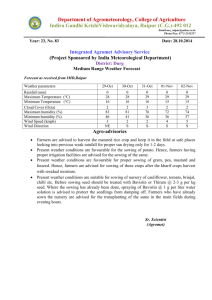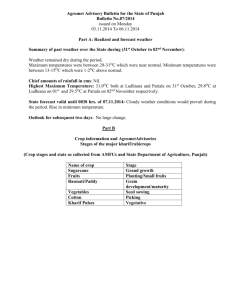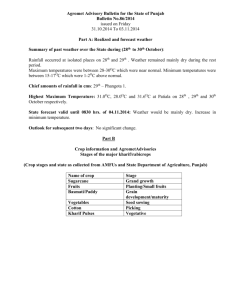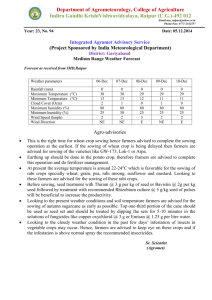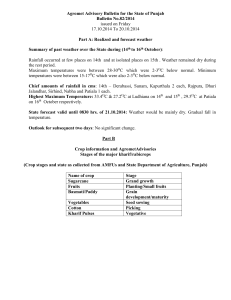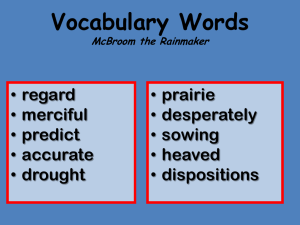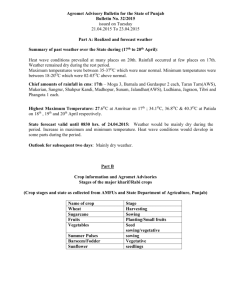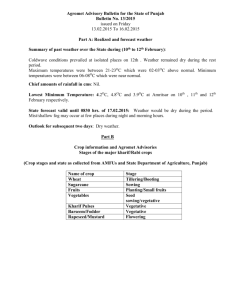Growth and development traits related to yield stability of
advertisement
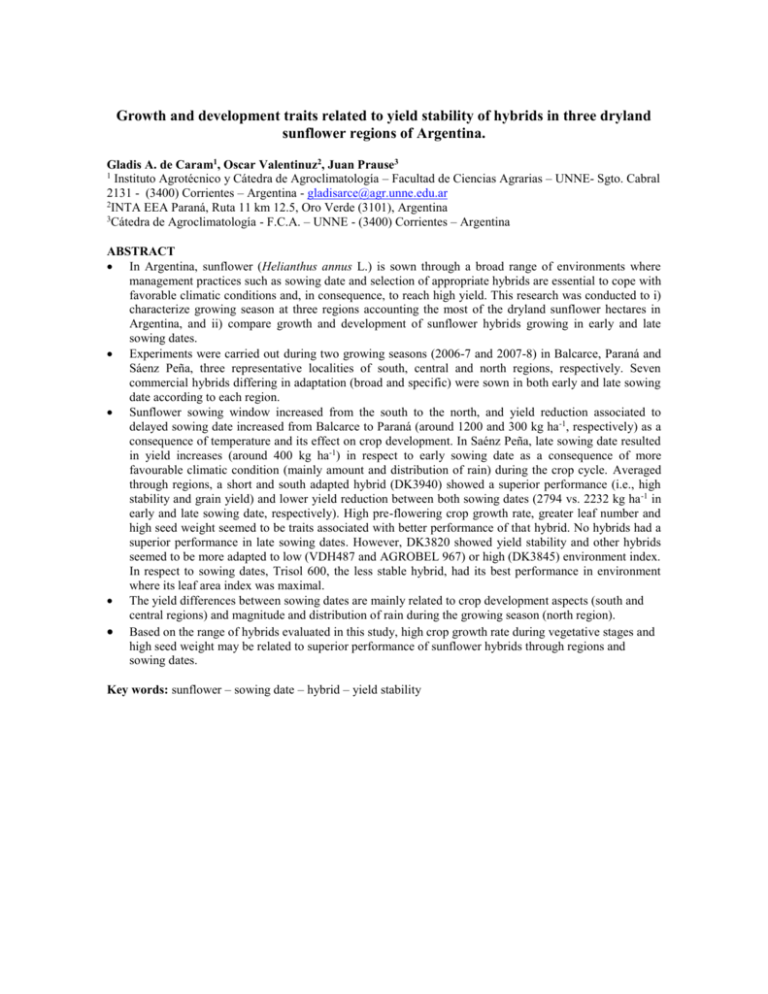
Growth and development traits related to yield stability of hybrids in three dryland sunflower regions of Argentina. Gladis A. de Caram1, Oscar Valentinuz2, Juan Prause3 1 Instituto Agrotécnico y Cátedra de Agroclimatología – Facultad de Ciencias Agrarias – UNNE- Sgto. Cabral 2131 - (3400) Corrientes – Argentina - gladisarce@agr.unne.edu.ar 2 INTA EEA Paraná, Ruta 11 km 12.5, Oro Verde (3101), Argentina 3 Cátedra de Agroclimatología - F.C.A. – UNNE - (3400) Corrientes – Argentina ABSTRACT In Argentina, sunflower (Helianthus annus L.) is sown through a broad range of environments where management practices such as sowing date and selection of appropriate hybrids are essential to cope with favorable climatic conditions and, in consequence, to reach high yield. This research was conducted to i) characterize growing season at three regions accounting the most of the dryland sunflower hectares in Argentina, and ii) compare growth and development of sunflower hybrids growing in early and late sowing dates. Experiments were carried out during two growing seasons (2006-7 and 2007-8) in Balcarce, Paraná and Sáenz Peña, three representative localities of south, central and north regions, respectively. Seven commercial hybrids differing in adaptation (broad and specific) were sown in both early and late sowing date according to each region. Sunflower sowing window increased from the south to the north, and yield reduction associated to delayed sowing date increased from Balcarce to Paraná (around 1200 and 300 kg ha -1, respectively) as a consequence of temperature and its effect on crop development. In Saénz Peña, late sowing date resulted in yield increases (around 400 kg ha-1) in respect to early sowing date as a consequence of more favourable climatic condition (mainly amount and distribution of rain) during the crop cycle. Averaged through regions, a short and south adapted hybrid (DK3940) showed a superior performance (i.e., high stability and grain yield) and lower yield reduction between both sowing dates (2794 vs. 2232 kg ha -1 in early and late sowing date, respectively). High pre-flowering crop growth rate, greater leaf number and high seed weight seemed to be traits associated with better performance of that hybrid. No hybrids had a superior performance in late sowing dates. However, DK3820 showed yield stability and other hybrids seemed to be more adapted to low (VDH487 and AGROBEL 967) or high (DK3845) environment index. In respect to sowing dates, Trisol 600, the less stable hybrid, had its best performance in environment where its leaf area index was maximal. The yield differences between sowing dates are mainly related to crop development aspects (south and central regions) and magnitude and distribution of rain during the growing season (north region). Based on the range of hybrids evaluated in this study, high crop growth rate during vegetative stages and high seed weight may be related to superior performance of sunflower hybrids through regions and sowing dates. Key words: sunflower – sowing date – hybrid – yield stability INTRODUCCION In Argentina, sunflower (Helianthus annus L.) is sown in a broad range of environments, from the Chaco Province (26º SL) to the south of Buenos Aires Province (39º SL). Gain yield differs among regions and subtropical areas shows lower grain yield (Pascale and Damario, 1995). Depending on latitude, sowing date, water availability and nutrition, sunflower cycle varies between 100 and 150 days (Díaz Zorita et al., 2003). Grain yield components are determined at different development stages during the crop cycle. In order to get high grain yield, crops need 1) high growth rates and 2) slow progress to development of phonological phases when setting and growing of grain occur (Aguirrezábal y Andrade, 2002). This study was carried out in order to i) characterize sunflower growing season at three well differenced production areas of sunflower in Argentina and, ii) compare growth and development of sunflower hybrids grown at early and late sowing date. MATERIALS AND METHODS Experiments were established at Balcarce (37º S, 58º W, hereafter named BA), Paraná (31º S, 60º W, hereafter named PA) and Saénz Pena (26º S, 60º W, hereafter named SP) during two growing seasons (2006-7 y 2007-08). ). Air temperature, rainfall and incident global radiation were obtained by weather stations situated around 500 m from experimental sites Seven sunflower hybrids selected from different breeding programs and differing in their adaptation (broad or narrow) were hand planted at two contrasting sowing dates (early and late) for each region (Table 1). For each sowing dates, hybrids were evaluated in a randomized complete block design with three replications. Plots were 8 m long by six rows wide. Row distances were 0.70 m (BA and SP) and 0.52 m (PA). Plant population density was 5 plants m-2. Daily air temperatures, rainfall and incident global radiation data were obtained by a weather station situated less than 500 m from the experimental sites. Table 1. Information of sunflower hybrids used at the experiments in 2006-7 and 2007-8 growing season.. Hybrid Company Cycle Pericarp AGROBEL 967 DK 3820 DK 3845 DK 3940 MG 2 TRISOL 600 VDH 487 Seminium Monsanto Monsanto Monsanto Dow Morgan Morgan Advanta Early Early Early Late Late Late Late Black hulled Black hulled Black hulled Stripped hulled Stripped hulled Stripped hulled Black hulled The experiments were hand planted on 12/09/09 and 20/09/2010. Plots were kept free of weeds and pests and fertilized with nitrogen (14 g m-2) at twenty days after crop emergence. Crop ontogeny was weekly recorded according to Schneither and Miller (1981). Leaf Area Index (LAI) was measured by using a LICOR 3100 planimeter (LI-COR, Lincoln, NE, USA). Total and partitioned aerial dry matter (DM) was estimated by sampling five plants per plot at flowering (DMR5.5) and physiological maturity (DMR9). Plants were partitioned in leaves, stem and head and then dried at 60º C in a forced-air drier to constant weight. Intercepted solar radiation was estimated (Dosio et al., 2000) by using a line quantum sensor (LICOR 191, Lincoln, USA). Crop growth rate (CGR) from crop emergence and anthesis was estimated according to (Gardner et al., 1985). Grain yield (GY) was estimated by removing heads from plants placed at the inner 3 m of the two center row of each plot. Heads were shelled and weighed and grain yield was adjusted to 0% moisture content. A combination of locations, growing seasons and sowing dates resulted in ten environments (Table 2). All data were analyzed with analysis of variance (ANOVA) and means separation was obtained by Fisher´s least significant differences (LSD). Principal components analysis was performed including growth, development and climatic data of environments by examining byplots (Bramardi, 2009). In addition, hybrid stability analysis of hybrids was performed by Finlay and Wilkinson (1963). All analyses were carried out by using procedures included at InfoStat (Di Rienzo et al., 2011). Sowing TM TMax TMin GR Rainfall date (°C) (°C) (°C) ( Mj. m-2 d-1) (mm) 2006-07 23-10-06 18.7 27.6 13.2 2707 322.8 BA61 2006-07 05-12-06 20.4 26.6 13.6 2416 95.5 BA62 2007-08 14-11-07 19.5 26.9 13.7 2185 282.1 BA71 2007-08 12-12-07 20.4 26.4 15.0 2002 374.6 BA72 2006-07 02-11-06 23.1 29.2 18.5 2685 919.0 PA61 2006-07 23-12-06 22.7 28.0 18.3 2418 1175.6 PA62 2007-08 18-12-07 24.1 29.7 18.3 1991 1865,3 PA72 2006-07 08-08-06 23.5 30.5 16.3 3360 530.2 SP61 2006-07 27-10-06 26.1 32.9 20.6 2997 495.4 SP62 2007-08 20-12-07 24.2 32.2 19.9 2105 383.5 SP72 Table 2. Climatic information of ten environments generated by combining locations, growing seasons and sowing date where sunflower hybrids were grown . Environments Season SD=sowing date; TM=mean temperature; TMax=maximum temperature; TMin= minimum temperature, GR= global radiation. Environments: Balcarce (BA), Paraná (PA), Sáenz Peña. (SP); growing season: 2006-07 (6), 2007-08 (7); sowing date: early (1), late (2). RESULTS AND DISCUSSION Across all locations, grain yield (GY) showed a broad range of values (Table 3). Sunflower performed better in BA than in PA and SP and hybrids showed different responses according to environments. Grain yield was maximal at BA71 y minimum at PA62 (Fig.1). Table 3. Analysis of variance for grain yield of sunflower hybrids grown at ten different environments. F.V. Ambiente Hibrido Ambiente>rep Hibrido*Ambiente Error SC 3608,74 1041,39 152,54 848,58 328,10 gl 9 6 24 54 114 CM 400,97 173,56 6,36 15,71 2,88 F 63,09 60,31 2,21 5,46 p-valor <0,0001 <0,0001 0,0029 <0,0001 The first two principal components accounted by 82% of data variation. PC1 explained 56% and reveled that greatest differences occurred among BA-PA and SP environments. By examining biplot (Fig. 2), thermal time (TT) from emergence to physiological maturity (TTE-R9), and from anthesis to physiological maturity (TTR5-R9), and oil percentage (OIL%) were positively associated with GY (Table 6). By the contrary, seed weight (SW) and IAF were negatively associated. A longer duration of reproductive period and delayed leaf senescence result in greater seed weight and, in consequence, a greater grain yield (Díaz Zorita et. al., 2003). PC2 explained 26% of data variation and most of variability was related with specific environments (BA61, BA62, BA71 y BA72) and associated with GY, IAF and SW (Fig. 2). Stability analysis revealed that, for early sowing date, DK 3940 showed greater GY stability and yield potential (Fig. 3A). When late sowing date were examined (Fig. 3B), slope ranged between 0.79 (VDH 487) y 1.26 (DK 3845). Only one (DK 3940) showed GY greater than the average across all environments (slope=1). DK 3845 performed better at low environment index, and MG2 y VDH 487 performed better at high environment index. T600 was the only hybrids showing GY lower than the average across all environments. This paper evaluated yield performance of sunflower hybrids growing at different locations and sowing dates. Hybrid response to three locations was different and could be related to lower IAF duration after anthesis and variations in incident solar radiation. GY differences due to changes at sowing dates are mainly associated with crop development aspects at central and south locations (PA and BA) and, with magnitude and distribution of rainfall during the growing season at the north location (SP). In respect to early sowing date, delayed sowing resulted in 40% reduction at potential grain yield as a consequence of reduced intercepted solar radiation during grain set and filling (Lopez Pereyra and Trapani, 2004). Late sowing date drastically shortened vegetative stages. Window for sowing was reduced from the north to the south. GY yield reduction due to delayed sowing date was greater at BA than in PA (1200 and 300 kg ha-1, respectively) and is consistent with those reported by Aguirrezábal and Andrade (2002). By the contrary, late sowing date resulted in greater GY at SP (c. 400 kg ha-1) when compared with early sowing date, as a consequence of greater amount and more favorable distribution of rainfall. The south adapted and early hybrid (DK3940) showed a superior performance (high and stable grain yield) and the lowest yield decline at late sowing date (2794 vs. 2232 kg ha-1). De la Vega and de la Fuente (2004) argued that short season hybrids often escape from stresses occurring at the end of growing. According to the group of hybrids evaluated in this study, ability for keeping both high crop growth rates during vegetative stages and seed weight could be related to superior performance of sunflower hybrids across regions and sowing dates. Figure 1. Sunflower grain yield at ten environments. Each bar indicates an averaged across hybrids. Black, white and grey bars correspond to Balcarce (BA), Paraná (PA) and Sáenz Peña (SP), respectively. Abbreviations are shown at Table 2. Figure 2. Biplot from Principal Component Analysis (PC). PC1 and PC2 account for 82% of data variability. Figure 3. Grain yield of sunflower hybrids and environmental index (Finlay and Wilkinson, 1963) growing at early (A) and late (B) sowing date environments. REFERENCES Aguirrezábal, L.A.N. and F.H. Andrade. 2002. Ecofisiología. En: Díaz Zorita, M. y Duarte, G.A. (eds.) Manual Práctico para el Cultivo de Girasol. Hemisferio Sur. Buenos Aires, Argentina. 27-49. Bramardi, S. J. 2009. Métodos de Análisis Multivariado. Universidad Nacional del Comahue. Universidad Nacional de La Plata. de la Vega, A.J., and E.B. de la Fuente. 2004. Capítulo 14. Elección de Genotipos. En Producción de Cultivos de Grano. Bases Fisiológicas para su manejo. Ed. Pascale, A.J. Editorial de la Facultad de Agronomía. Universidad de Buenos Aires.783 pp. Di Rienzo J.A., F. Casanoves, M. G. Balzarini, L. Gonzalez, M. Tablada, and C. W. Robledo. InfoStat versión 2011. Grupo InfoStat, FCA, Universidad Nacional de Córdoba, Argentina. URL. http://www.infostat.com.ar. Díaz Zorita, M., G. Duarte, and E. Plante. 2003. El Cultivo de Girasol. ASAGIR (eds). Asociación Argentina de Girasol. Dosio, G. A, L. A: N. Aguirrezábal, F. H. Andrade, and V. R. Pereyra. 2000. Solar radiation intercepted during seed filling and oil production in two sunflower hybrids. Crop Science 40: 1637-1640 Finlay. K.E., and G.N. Wilkinson. 1963. The analysis of adaptation in a plant breeding programme. Aust. J. Agric. Res. 14:742-754. Gadner, F. P.; R. B. Pearce, and R. L. Mitchel. 1985. Physiology of crop plants. Iowa State University Press. USA. 327p. López Pereira, M., and N. Trápani. 2004. Capítulo 3: Importancia de Factores Abióticos que Limitan el rendimiento y la Calidad del Girasol. En: “El cultivo de girasol en siembra directa”. Argentina. 1° Ed. Buenos Aires. Monsanto. Pascale A., and E Damario. 2005. Bioclimatología Agrícola y Agroclimatología. Editorial de la Facultad de Agronomía. Universidad de Buenos Aires. 576 pp Sheneiter, A.A. and J.F. Miller. 1981. Description of sunflower growth stages. Crop.Sci. 21: 901-903.
